
|
|
|
| synonym |
|
| description |
Orange-yellow overall, with a broad wavy line on the anterior margin of the vertex and four quadrate spots above this; the central pair of spots are larger. The wings are a smoky yellow-orange color, with yellow-orange venation. The female pregenital sternite is broadly and angularly excavated; note that the excavation is rounded and is broad and moderately deep. The male genital plates are elongate, gradually tapering to blunt apexes. Adults are 5.0-5.5 mm long. (DeLong 1948)
For diagrams of this species, see: 3I. For nice images of an adult, see: BG. |
| distribution |
Eastern United States |
| abundance |
Rare, recorded from a single county in both the Coastal Plain and Piedmont; likely more abundant in the right habitat. |
| seasonal_occurrence | |
| habitat |
Moist areas where the host plant grows. |
| plant associates |
Cane/native bamboo (Arundinaria tecta) |
| behavior |
Can be attracted at night with a light. |
| comments |
NOTE: Arundanus is a genus that consists of a number of species that look like one another. It is therefore important to get a clear, detailed picture of the underside to determine species identification. |
status |
[Native:]
[Introduced:]
[Extirpated:] | | list_type |
[Official:]
[Provisional:] |
| adult_id | Unmistakable and widely known Identifiable from good quality photos of unworn specimens
Identifiable from photos showing undersides, or other specialized views [e.g., legs, face]
Identifiable only by close inspection of structural features or by DNA analysis NULL |
| nymph_id | Unmistakable and widely known Identifiable from good quality photos, especially where associated with known host plants
Identifiable from close inspection of specimens or by DNA analysis
Identifiable only through rearing to adulthood NULL |
| G_rank |
GNR [G3] |
| S_rank |
[SU] |
| rank_comments |
r - Known in NC from a single record; feeds on Switch Cane (S5) and may be found more widely in the Coastal Plain |
| tribe |
Deltocephalini |
| subgenus |
|
Species Photo Gallery for Arundanus crumbi No Common Name |
 | Photo by: Paul Scharf, B Bockhahn, C Mitchell
Durham Co.
Comment: Attracted to UV Light |

 »
»
 »
»